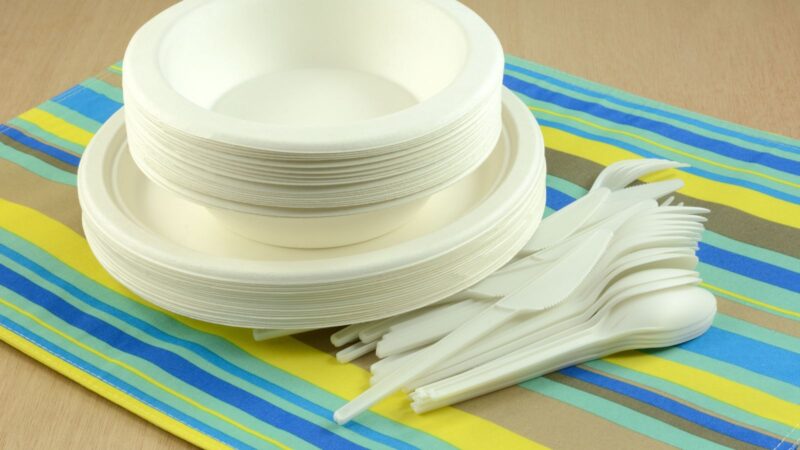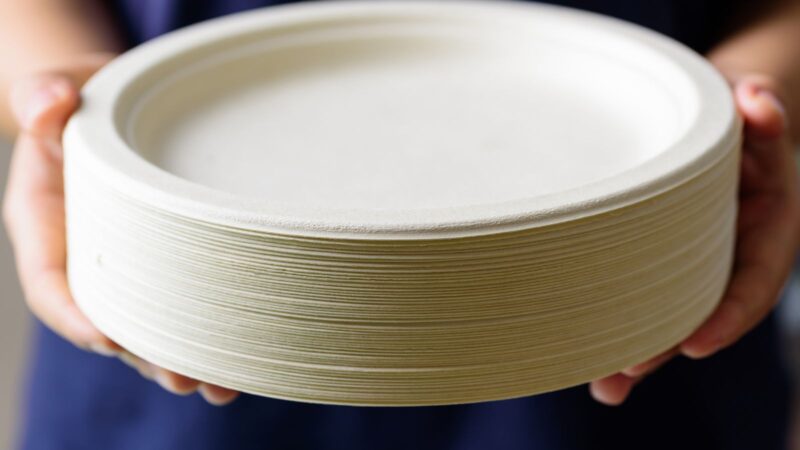Did you know that you can enjoy delicious meals that nourish both your body and the planet by adopting just one simple practice? This holistic approach considers the impact of food production on our environment, promoting sustainable practices that minimize waste and reduce our carbon footprint. As we face growing environmental challenges mostly caused by human activities, embracing sustainable practices in the food industry has never been more important.
Imagine savoring your favorite dish on a compostable plate, knowing that with every bite, you’re making a positive impact on the environment. Using compostable plates is a key element of eco-friendly dining that restaurant owners and the food industry as a whole can benefit from and also contribute to the solution to environmental degradation.
Understanding Compostable Plates
Compostable plates are a greener alternative to traditional disposable plates. They are typically crafted from plant-based materials like bamboo, designed to break down naturally over time without leaving behind harmful residues. Compared to some types of plastic, they often require less energy to produce and can be composted under the right conditions. A closer look at some of these organic materials, we have:
- Bagasse: this material is naturally sourced from sugarcane. It is the residue left after sugarcane stalks are pressed and the juice is extracted.
- Bamboo: this is a strong, fast-growing plant that does not require pesticides or irrigation, making it an excellent, easily renewable source of material.
- Palm Tree Leaves: these are leaves from palm trees that fall naturally as the tree matures. Collecting these leaves for processing does not physically harm the trees or contribute to deforestation.
Environmental Benefits of Compostable Plates
Reduction in Plastic Waste
Compostable plates play a significant role in reducing reliance on plastic products, unlike traditional plastic plates, which are derived from non-renewable petroleum resources and contribute to persistent environmental pollution. This switch from non-renewable to renewable materials helps decrease the demand for fossil fuels and reduces the environmental footprint of single-use items.
Compostable materials decompose through natural processes facilitated by microorganisms. When compostable plates are disposed of in a composting facility, they break down into organic matter, water, and carbon dioxide within a few months. This decomposition process is beneficial for the environment as it:
- Reduces landfill waste: Compostable plates do not contribute to the accumulation of non-degradable waste in landfills.
- Enhances soil quality: The decomposed material can be used as nutrient-rich compost, improving soil health and fertility.
Furthermore, plastic pollution is a severe threat to marine life and ecosystems. Plastic debris can be ingested by marine animals, leading to injury, starvation, and death. By reducing plastic waste, compostable plates help mitigate these harmful effects.
Read More: 6 Things To Consider When Choosing Food Product Packaging
Lower Carbon Footprint
You know, it’s pretty cool how compostable plates can actually help lower our carbon footprint. When we talk about carbon emissions, we’re usually thinking about cars or factories. But even the stuff we use every day, like plates, can make a difference.
During the production of traditional plastic plates, materials that come from oil and gas are used and these aren’t exactly renewable resources. But compostable plates? They are often made from things like plant fibers, which soak up carbon dioxide as they grow. So, right off the bat, we are already doing something good for the environment just by choosing compostable over plastic.
Another great thing about compostable plates is how easy they are on energy usage during manufacturing. You see, because they’re made from plant-based materials, they don’t need to be heated up to crazy-high temperatures. Plus, the whole production process is often less complicated and energy-intensive compared to making synthetic plastics.
Restaurant owners and businesses that offer catering services can take advantage of this eco-friendly action. A cafe or restaurant that decides to swap out its regular plastic plates for compostable ones will not only cut down on waste but also show its customers they care about the health of the environment. Even companies hosting events can use compostable plates to minimize waste and showcase their environmental responsibility.
Promotion of Sustainable Practices
The food industry can promote sustainability by integrating compostable plates into their operations. This approach can be part of a broader strategy for sustainability. Using compostable plates aligns with initiatives such as zero waste goals and sustainable sourcing.
There are a good number of restaurants and food service providers that have successfully implemented compostable plates like Sweetgreen, a popular salad chain that uses compostable bowls and plates to reduce waste and promote sustainability, and Chipotle, a restaurant chain that uses compostable cutlery and packaging.
If you are already considering switching to compostable plates in your food industry, then you’re likely ready. Here are some tips to make the transition smoother:
- First off, take a good look at your current practices. Where can you cut down on waste and make room for compostable alternatives? It’s all about finding those opportunities for improvement.
- Next, when you’re sourcing compostable products, make sure you’re choosing suppliers who are as committed to sustainability as you are. Look for certifications and industry standards to ensure you’re getting the real deal.
- Once you’ve got your compostable plates in hand, make sure everyone knows how to use them properly. Train your staff on the ins and outs of compostable disposal, and educate your customers on why it matters.
- Don’t forget to team up with your local waste management services. Work together to ensure that your compostable plates are being processed correctly and making their way back into the earth where they belong.
- Lastly, keep track of your progress. Monitor the impact of switching to compostable plates and share those results with your stakeholders. Let others see your commitment to sustainability and get inspired to be part of the journey.
Economic Benefits of Using Compostable Plates
[2] Cost-Effectiveness
While the initial production cost of compostable plates might be slightly higher than traditional plastic disposable plates, the long-term financial benefits are undeniable. By switching to compostable options, businesses can significantly reduce their waste disposal fees. Additionally, some compostable materials can be reused or recycled, further enhancing their cost-effectiveness.
Investing in compostable plates is an investment in sustainability and financial prudence. It’s a decision that benefits the environment and your bottom line.
Enhanced Brand Image
Embracing eco-friendly dining practices, such as using compostable plates, can significantly enhance your brand image. Today’s consumers are increasingly conscious of environmental issues and actively seek out businesses that align with their values. A stronger brand image translates to increased consumer loyalty and potential partnerships with other environmentally responsible businesses. You can simultaneously protect the environment and grow your business.
Customer Satisfaction
Using compostable plates can indeed contribute to customer satisfaction. Many consumers today are environmentally conscious and appreciate businesses that align with their values. By opting for compostable tableware, you demonstrate your commitment to sustainability, leaving customers with a positive feeling about their dining experience and their impact on the environment.
Conclusion
Embracing compostable plates is a clear win-win for both your business and the environment. By transitioning to these eco-friendly alternatives, you not only reduce plastic waste and lower your carbon footprint but also elevate your brand image and appeal to environmentally conscious consumers.
The long-term cost benefits, increased customer satisfaction, and positive environmental impact make compostable plates a smart choice for any food service business. We encourage restaurant and food business owners to take a step towards sustainability by transitioning to compostable plates. To learn more about compostable plates and discover reputable suppliers, consider exploring the resources available at Green Paper Products.
https://www.pexels.com/photo/light-bulb-paper-cup-plate-forks-and-recycling-pictograph-6990568/
https://www.pexels.com/photo/person-in-orange-shirt-holding-aluminum-rectangular-container-104884/



